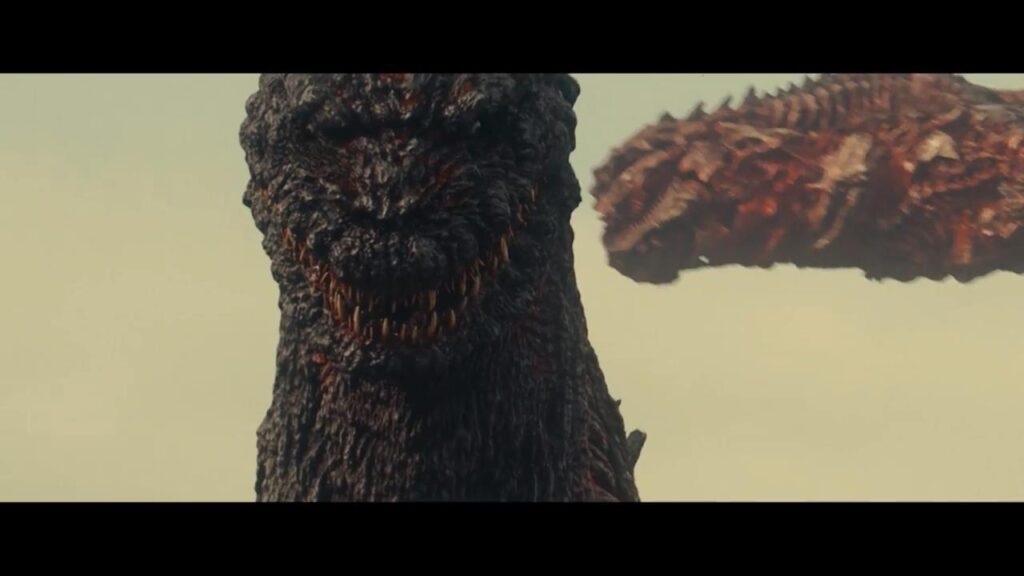I loved Godzilla when I was a kid. I had a whole collection of VHS tapes that I’d stretch out rewinding and re-watching my favorite scenes over and over. I loved (and still love) that original roar, and always thought that Godzilla was more cute like a pet than scary like a monster.
In 1998, Roland Emmerich, of Independence Day fame, tried to refranchise Godzilla and failed miserably. That disaster is barely worth mentioning.
In 2014, Legendary Pictures took a much more successful crack at it. It was decent (decent enough for me to buy), but there weren’t enough of the monsters. When they did focus on the monsters it was good, but there was just something missing.
I personally had no idea that Toho Pictures, the original creator of Godzilla, was even still around, let alone to make another movie. I saw the trailer by mistake while trolling YouTube. Needless to say, it was an effective trailer, because within the first few seconds my spine started tingling.
Toho’s Shin Godzilla (Godzilla Resurgence) is a real Godzilla movie. While Legendary is decent at taking super hero and other SciFi themes (e.g. Inception) and making them seem realistic and possible, this is not what Godzilla movies are supposed to be. They’re supposed to be satirical, campy, and downright ridiculous. Shin Godzilla nailed it, though it should be no surprise that it did.
…Toho’s new Godzilla has the real, original roar…
To understand one reason why Shin was so perfect, one must go back to the original 1954 movie. Godzilla was created as an allegory for the dangers and consequences of nuclear warfare. When Godzilla was released, it was not ten years after the bombings of Nagasaki and Hiroshima, and the more
recent Bikini Atoll nuclear testing was also striking a Japanese nerve with the Lucky Dragon 5 incident. So Godzilla was more than just a “fun” movie about a reckless monster wreaking havoc on Tokyo; it was a statement of protest.
In 2016, the Fukushima disaster is still fresh in the Japanese mind, and after watching Shin Godzilla, it appears that their government has far more bureaucratic problems than we in the US do. At the start, when Godzilla first starts bubbling below the bay springing a leak in a tunnel, the film depicts an absolute nightmare of the Japanese government’s ability to respond to a disaster. A large group of bureaucrats meet to discuss the situation, are unable to find a solution, so get up and move to another room because maybe it’s a different type of disaster. Theories are thrown around, the feasible one ignored, and nothing gets done. The “experts” called in compound the confusion, and refuse to stake their reputation on something they can’t study extensively, despite there being no time to do so. This theme recurs throughout the movie, and plays out in a most amusing way. I laughed out loud throughout at the sheer ridiculousness of it. Afterward, I wondered if this is what the Tokyo government looked like after Fukushima started.

Godzilla’s appearance was just as it should be: he looks like the original in high resolution. The way he first makes landfall was unexpected, but not in a negative way. Most importantly, Toho’s new Godzilla has the real, original roar. From what I understand, the sound comes from running a glove along the string of a contrabass. Whatever it is, it is the only roar Godzilla should ever have—it’s as essential to his identity as his name.
When Godzilla finally appears, after much comedic debate, the irresolute officials come to the consensus that he must be destroyed. The bureaucracy again stalls at the fear of collateral damage during the first encounter. What’s interesting about that scene is that Godzilla, though wreaking havoc on the suburbs of Tokyo simply because he’s moving, he doesn’t seem bent on hurting anything. He’s just out for a walk! Even when faced with the helicopters about to unleash fury on him, the kaiju just looks at them with curiosity. When the helicopters do not engage, Godzilla returns hastily to the sea like an excited puppy. Here we’re faced with an interesting dilemma: is it really necessary to condemn and destroy things that we don’t understand?
Godzilla doesn’t really attack until the American B-2 bombers actually wound him (tanks & artillery naturally don’t make a scratch). After that…well…you can guess what happens when Godzilla gets pissed. The special effects are great, but the filmmakers were sure to include tight shots of angry Godzilla roaring and shaking his head, as was present in the originals. I did notice throughout the whole movie that although they used CGI, the filmmakers at times made the CGI and certain shots reminiscent of the old Godzilla movies. It was a nice touch.
The music was also scored well. Certain of the songs were from original Godzilla movies, but the new score was crafted to reflect the original sixties-esque monster/disaster film scores, which was of course highly appropriate. The movie would not have had the same feeling without it.
As this is not a harsh critical review, I won’t spoil the end. I will say that it is yet again the filmmakers’ goal to make a statement to the audience about codependence vs independence and the human thirst to destroy as opposed to taking the effort to understand, have patience, and coexist. Unfortunately, I did not have the luxury of being able to rewind in the theater to really study the last shot. What was going on with that tail required further scrutiny…
Overall, Shin Godzilla was a visually stunning, lighthearted but thrilling film. It appropriately melded modern filmmaking with the original elements of what made the King of the Monsters lovable. Finally the Godzilla I remember from my childhood has returned.
